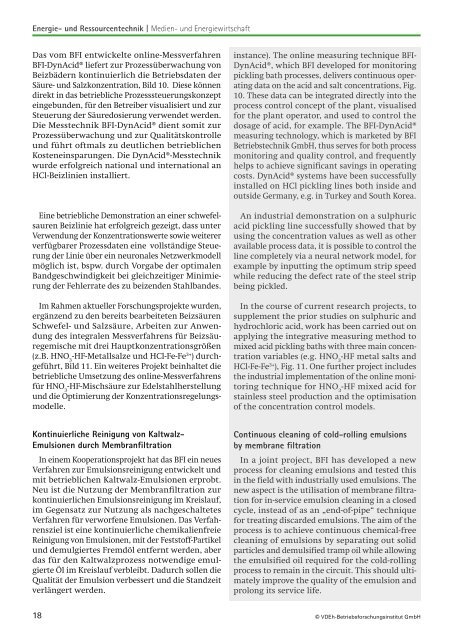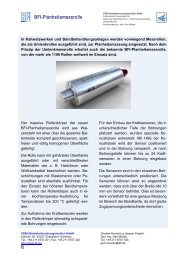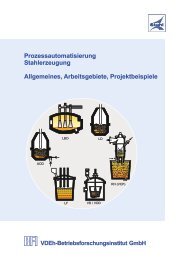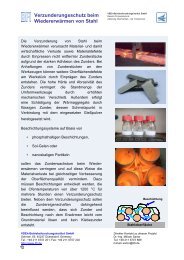Tätigkeitsbericht /Activity Report 2011/2012 - BFI.de
Tätigkeitsbericht /Activity Report 2011/2012 - BFI.de
Tätigkeitsbericht /Activity Report 2011/2012 - BFI.de
Erfolgreiche ePaper selbst erstellen
Machen Sie aus Ihren PDF Publikationen ein blätterbares Flipbook mit unserer einzigartigen Google optimierten e-Paper Software.
Energie- und Ressourcentechnik | Medien- und Energiewirtschaft<br />
Das vom <strong>BFI</strong> entwickelte online-Messverfahren<br />
<strong>BFI</strong>-DynAcid® liefert zur Prozessüberwachung von<br />
Beizbä<strong>de</strong>rn kontinuierlich die Betriebsdaten <strong>de</strong>r<br />
Säure- und Salzkonzentration, Bild 10. Diese können<br />
direkt in das betriebliche Prozesssteuerungskonzept<br />
eingebun<strong>de</strong>n, für <strong>de</strong>n Betreiber visualisiert und zur<br />
Steuerung <strong>de</strong>r Säuredosierung verwen<strong>de</strong>t wer<strong>de</strong>n.<br />
Die Messtechnik <strong>BFI</strong>-DynAcid® dient somit zur<br />
Prozessüberwachung und zur Qualitätskontrolle<br />
und führt oftmals zu <strong>de</strong>utlichen betrieblichen<br />
Kosteneinsparungen. Die DynAcid®-Messtechnik<br />
wur<strong>de</strong> erfolgreich national und international an<br />
HCl-Beizlinien installiert.<br />
Eine betriebliche Demonstration an einer schwefelsauren<br />
Beizlinie hat erfolgreich gezeigt, dass unter<br />
Verwendung <strong>de</strong>r Konzentrationswerte sowie weiterer<br />
verfügbarer Prozessdaten eine vollständige Steuerung<br />
<strong>de</strong>r Linie über ein neuronales Netzwerkmo<strong>de</strong>ll<br />
möglich ist, bspw. durch Vorgabe <strong>de</strong>r optimalen<br />
Bandgeschwindigkeit bei gleichzeitiger Minimierung<br />
<strong>de</strong>r Fehlerrate <strong>de</strong>s zu beizen<strong>de</strong>n Stahlban<strong>de</strong>s.<br />
Im Rahmen aktueller Forschungsprojekte wur<strong>de</strong>n,<br />
ergänzend zu <strong>de</strong>n bereits bearbeiteten Beizsäuren<br />
Schwefel- und Salzsäure, Arbeiten zur Anwendung<br />
<strong>de</strong>s integralen Messverfahrens für Beizsäuregemische<br />
mit drei Hauptkonzentrationsgrößen<br />
(z.B. HNO 3<br />
-HF-Metallsalze und HCl-Fe-Fe 3+ ) durchgeführt,<br />
Bild 11. Ein weiteres Projekt beinhaltet die<br />
betriebliche Umsetzung <strong>de</strong>s online-Messverfahrens<br />
für HNO 3<br />
-HF-Mischsäure zur E<strong>de</strong>lstahlherstellung<br />
und die Optimierung <strong>de</strong>r Konzentrationsregelungsmo<strong>de</strong>lle.<br />
instance). The online measuring technique <strong>BFI</strong>-<br />
DynAcid®, which <strong>BFI</strong> <strong>de</strong>veloped for monitoring<br />
pickling bath processes, <strong>de</strong>livers continuous operating<br />
data on the acid and salt concentrations, Fig.<br />
10. These data can be integrated directly into the<br />
process control concept of the plant, visualised<br />
for the plant operator, and used to control the<br />
dosage of acid, for example. The <strong>BFI</strong>-DynAcid®<br />
measuring technology, which is marketed by <strong>BFI</strong><br />
Betriebstechnik GmbH, thus serves for both process<br />
monitoring and quality control, and frequently<br />
helps to achieve significant savings in operating<br />
costs. DynAcid® systems have been successfully<br />
installed on HCl pickling lines both insi<strong>de</strong> and<br />
outsi<strong>de</strong> Germany, e.g. in Turkey and South Korea.<br />
An industrial <strong>de</strong>monstration on a sulphuric<br />
acid pickling line successfully showed that by<br />
using the concentration values as well as other<br />
available process data, it is possible to control the<br />
line completely via a neural network mo<strong>de</strong>l, for<br />
example by inputting the optimum strip speed<br />
while reducing the <strong>de</strong>fect rate of the steel strip<br />
being pickled.<br />
In the course of current research projects, to<br />
supplement the prior studies on sulphuric and<br />
hydrochloric acid, work has been carried out on<br />
applying the integrative measuring method to<br />
mixed acid pickling baths with three main concentration<br />
variables (e.g. HNO 3<br />
-HF metal salts and<br />
HCl-Fe-Fe 3+ ), Fig. 11. One further project inclu<strong>de</strong>s<br />
the industrial implementation of the online monitoring<br />
technique for HNO 3<br />
-HF mixed acid for<br />
stainless steel production and the optimisation<br />
of the concentration control mo<strong>de</strong>ls.<br />
Kontinuierliche Reinigung von Kaltwalz-<br />
Emulsionen durch Membranfiltration<br />
In einem Kooperationsprojekt hat das <strong>BFI</strong> ein neues<br />
Verfahren zur Emulsionsreinigung entwickelt und<br />
mit betrieblichen Kaltwalz-Emulsionen erprobt.<br />
Neu ist die Nutzung <strong>de</strong>r Membranfiltration zur<br />
kontinuierlichen Emulsionsreinigung im Kreislauf,<br />
im Gegensatz zur Nutzung als nachgeschaltetes<br />
Verfahren für verworfene Emulsionen. Das Verfahrensziel<br />
ist eine kontinuierliche chemikalienfreie<br />
Reinigung von Emulsionen, mit <strong>de</strong>r Feststoff-Partikel<br />
und <strong>de</strong>mulgiertes Fremdöl entfernt wer<strong>de</strong>n, aber<br />
das für <strong>de</strong>n Kaltwalzprozess notwendige emulgierte<br />
Öl im Kreislauf verbleibt. Dadurch sollen die<br />
Qualität <strong>de</strong>r Emulsion verbessert und die Standzeit<br />
verlängert wer<strong>de</strong>n.<br />
Continuous cleaning of cold-rolling emulsions<br />
by membrane filtration<br />
In a joint project, <strong>BFI</strong> has <strong>de</strong>veloped a new<br />
process for cleaning emulsions and tested this<br />
in the field with industrially used emulsions. The<br />
new aspect is the utilisation of membrane filtration<br />
for in-service emulsion cleaning in a closed<br />
cycle, instead of as an „end-of-pipe“ technique<br />
for treating discar<strong>de</strong>d emulsions. The aim of the<br />
process is to achieve continuous chemical-free<br />
cleaning of emulsions by separating out solid<br />
particles and <strong>de</strong>mulsified tramp oil while allowing<br />
the emulsified oil required for the cold-rolling<br />
process to remain in the circuit. This should ultimately<br />
improve the quality of the emulsion and<br />
prolong its service life.<br />
18 © VDEh-Betriebsforschungsinstitut GmbH













